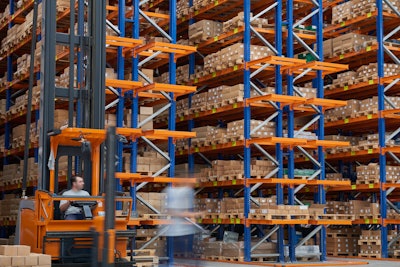
By definition inventory optimization is the process of scientifically determining the right inventory levels across the supply chain. Sounds simple enough. Yet, for today’s retailers, managing their inventory in a customer-centric, omnichannel world is a challenge.
What might sound like a customer service complaint to the average shopper is now increasingly a supply chain problem. Why is the pair of shoes they’ve been eyeing online out of stock at their local retail location? Many retail supply chain teams are still working to find the answer. A separation of e-commerce and brick-and-mortar inventory is one factor.
“As they launched their direct-to-consumer business or their e-commerce business, many of those retailers set up different silos of inventory—this inventory was for e-commerce and that inventory was for brick and mortar,” explains Karin Bursa, executive vice president at Logility. “The bad behavior if you will, or the bad habit of creating these silos of inventory, has created some interesting challenges for retailers in that they could be out of stock at a retail store and be sitting on inventory for their e-com business.
Log in to view the full article
By definition inventory optimization is the process of scientifically determining the right inventory levels across the supply chain. Sounds simple enough. Yet, for today’s retailers, managing their inventory in a customer-centric, omnichannel world is a challenge.
What might sound like a customer service complaint to the average shopper is now increasingly a supply chain problem. Why is the pair of shoes they’ve been eyeing online out of stock at their local retail location? Many retail supply chain teams are still working to find the answer. A separation of e-commerce and brick-and-mortar inventory is one factor.
“As they launched their direct-to-consumer business or their e-commerce business, many of those retailers set up different silos of inventory—this inventory was for e-commerce and that inventory was for brick and mortar,” explains Karin Bursa, executive vice president at Logility. “The bad behavior if you will, or the bad habit of creating these silos of inventory, has created some interesting challenges for retailers in that they could be out of stock at a retail store and be sitting on inventory for their e-com business.
“The opportunity is to unify that view and get that inventory to the place that it’s most likely to sell next. That’s where this whole optimization, the math behind it, is allowing retailers to get better visibility,” she adds. Instead of managing inventory like two separate lines of business, Logility is helping its customers bring them together. The biggest challenge in creating this omnichannel approach, however, is that there is no one-size-fits-all solution to inventory management.
“When everyone identified that e-commerce players were starting to take market share and they were starting to see lost sales, the immediate knee-jerk reaction was to then offer similar service levels, offer free shipping, offer next day service,” explains Toby Brzoznowski, co-founder and chief strategy officer of LLamasoft. “So many companies moved as rapidly as possible to try to make those offers, not understanding what the actual cost to serve was and what that would do to their margins.
“What many companies quickly identified is that if they were to offer that type of service for all products, they were drastically impacting their margins and their profitability,” Brzoznowski adds.
That immediate reaction has been tempered now, however, with a much more practical, data-driven approach that identifies which products should rationally be sold and offered at a high service level. As opposed to offering a one-size-fits-all strategy, Brzoznowski says retailers are looking to digital models.
“They’re using more sophisticated demand analytics and cost-to-serve analytics to really determine their overall retail and service-level policies,” he adds.
Thus, the design aspect of the supply chain has become more critical.
“You can only execute as good as your design. No matter how well they execute, they’re only going to get so good. You can’t improve any further until you redesign,” Brzoznowski says. “There has been a traditional focus on and investment in execution. The real competitive advantage is companies that are stepping back and leveraging more advanced analytics to redesign and continuously redesign because things are always changing.”
Understanding Demand
LLamasoft is focused specifically on the idea of supply chain design, or helping its customers focus on the metrics that ultimately drive inventory and service. The first step in that process is understanding demand—understanding the frequency with which each individual item, and the variability of each individual location and item combination, is happening.
“The companies that seem to be best-in-class are doing a much more detailed analysis of demand patterns than they have ever done before—the way in which customers are buying things and the way in which they’re expecting service,” Brzoznowski explains.
This trend toward a more demand-driven supply chain has also led to a more proactive approach. Through advances in technology and greater insights provided by data and analytics, retailers can now manage inventory levels based on actual demand rather than forecasted demand.
“One of the biggest mistakes people make is they assume everything is the same,” Brzoznowski says. “They try to promise the same level of service for every product and to every customer. It’s simply not a good strategy because of this variability and the different types of demand patterns.
“If you tried to promise the same level of service and treat inventory the same across all the different products, you would way overstock some items and you would highly understock others,” he adds.
Ed Elsbury, associate partner at Reveal, says a traditional reactive approach to demand often results in excess inventory.
“What we often find are inefficiencies in processes and in people’s understanding of how to manage their inventories and how to utilize their tools to manage those inventories. Companies tend to drown those inefficiencies with inventory, which is costing them in a number of different ways. It costs them in tied up working capital, and it ties up bin space that could be utilized for faster moving, more profitable items,” he explains.
At Reveal, Elsbury says they are helping customers understand how to utilize sales and improve operational planning to get ahead of market trends and better utilize forecasts based on more than historical data.
“If you’re a retailer and you’ve got to keep certain items on the shelf at the stores, then understanding your forecasts and understanding those usage histories and the information that’s available to you—and then being able to utilize the system for reordering and making sure that you have those right materials at the right place at the right time—is critical,” Elsbury says.
“If you’re a materials buyer, you’ve got to go off of some kind of demand signal,” he adds. “If the forecasts aren’t in the system, then what am I buying off of? The only thing I’m buying off of typically is just historical usage.”
And as retailers get closer to the end consumer, demand signals are increasingly coming directly from them, through social media.
“There’s so much more information, and the process to pull that information out in different ways is changing,” Elsbury says. “The ability for a company to take data, make it actionable and then execute is the Holy Grail companies are searching for. If you could align your master data and your business behaviors to how you operate as a business, the profitability would increase exponentially.”
A Focus on Actual Cost to Serve
Once you understand demand patterns and segment inventory based on the different types of behaviors—identifying which ones are fast moving, which ones are very normal in frequency and which ones are higher margin versus others—retailers must then understand what their actual costs to serve each product are, Brzoznowsk says.
“People are focusing a lot of attention on: ‘What is the actual cost to serve or margin to serve each product to each customer?’ Because if you understand what the buying behaviors and demand patterns are, and you understand your margin to serve, you can identify a certain group and category of products that are absolutely essential to offer the highest level of service,” he says.
These are your high margin, high volume, high frequency and low variability-type products. These are the products that require higher, more expensive transportation costs to get them to the customer no matter what.
Categorizing demand, and therefore understanding the actual cost to serve, will also help you identify the products that are neither high volume, low variability nor high margin.
“Those are the items you have to have a discipline as a retailer to avoid the risk of promising high availability or high service because those are items that will ultimately ruin your profitability,” Brzoznowski says. “You have to be willing to offer lower service or offset your costs with requiring additional shipping or handling costs in order to expedite service. Those are the ones that wouldn’t necessarily qualify for free shipping.”
From there, the next step is understanding the areas within the supply chain that introduce variability (variability in lead times, transportation and production).
“If you can understand variability, if you can understand your cost to serve, if you can understand your demand behaviors, those three elements are going to help you create a design that can accommodate all of them,” Brzoznowski adds. “The companies that can design and adapt faster are the ones that are going to have an edge on their competitors. Unless you have that digital model to identify all of the options that are available to you and allow you to experiment, you’re really stuck.”
Elsbury agrees, adding the biggest impact will come from companies that have revised their processes, improved data integrity and developed the knowledge level of users.
“The tools have always been there… but organizations are starting to realize that they’ve been underutilizing them. If organizations could just fundamentally improve performance with tools that they have available to them today, it’s incredible the results that can be achieved.”
Follow Amy Wunderlin on Twitter.
















![Pros To Know 2026 [color]](https://img.sdcexec.com/mindful/acbm/workspaces/default/uploads/2025/08/prostoknow-2026-color.mduFvhpgMk.png?ar=16%3A9&auto=format%2Ccompress&bg=fff&fill-color=fff&fit=fill&h=135&q=70&w=240)